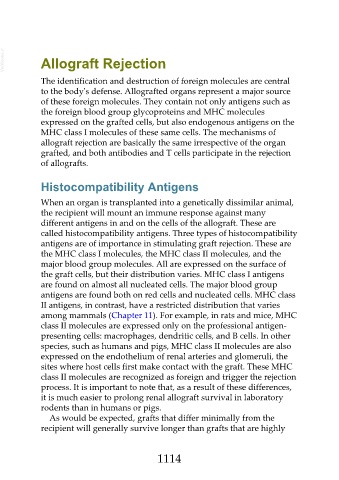Page 1114 - Veterinary Immunology, 10th Edition
P. 1114
VetBooks.ir Allograft Rejection
The identification and destruction of foreign molecules are central
to the body's defense. Allografted organs represent a major source
of these foreign molecules. They contain not only antigens such as
the foreign blood group glycoproteins and MHC molecules
expressed on the grafted cells, but also endogenous antigens on the
MHC class I molecules of these same cells. The mechanisms of
allograft rejection are basically the same irrespective of the organ
grafted, and both antibodies and T cells participate in the rejection
of allografts.
Histocompatibility Antigens
When an organ is transplanted into a genetically dissimilar animal,
the recipient will mount an immune response against many
different antigens in and on the cells of the allograft. These are
called histocompatibility antigens. Three types of histocompatibility
antigens are of importance in stimulating graft rejection. These are
the MHC class I molecules, the MHC class II molecules, and the
major blood group molecules. All are expressed on the surface of
the graft cells, but their distribution varies. MHC class I antigens
are found on almost all nucleated cells. The major blood group
antigens are found both on red cells and nucleated cells. MHC class
II antigens, in contrast, have a restricted distribution that varies
among mammals (Chapter 11). For example, in rats and mice, MHC
class II molecules are expressed only on the professional antigen-
presenting cells: macrophages, dendritic cells, and B cells. In other
species, such as humans and pigs, MHC class II molecules are also
expressed on the endothelium of renal arteries and glomeruli, the
sites where host cells first make contact with the graft. These MHC
class II molecules are recognized as foreign and trigger the rejection
process. It is important to note that, as a result of these differences,
it is much easier to prolong renal allograft survival in laboratory
rodents than in humans or pigs.
As would be expected, grafts that differ minimally from the
recipient will generally survive longer than grafts that are highly
1114

